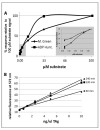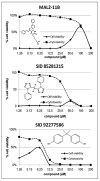High-throughput screening identifies a bisphenol inhibitor of SV40 large T antigen ATPase activity
- PMID: 21948801
- PMCID: PMC3731742
- DOI: 10.1177/1087057111421630
High-throughput screening identifies a bisphenol inhibitor of SV40 large T antigen ATPase activity
Abstract
The authors conducted a high-throughput screening campaign for inhibitors of SV40 large T antigen ATPase activity to identify candidate antivirals that target the replication of polyomaviruses. The primary assay was adapted to 1536-well microplates and used to screen the National Institutes of Health Molecular Libraries Probe Centers Network library of 306 015 compounds. The primary screen had an Z value of ~0.68, signal/background = 3, and a high (5%) DMSO tolerance. Two counterscreens and two secondary assays were used to prioritize hits by EC(50), cytotoxicity, target specificity, and off-target effects. Hits that inhibited ATPase activity by >44% in the primary screen were tested in dose-response efficacy and eukaryotic cytotoxicity assays. After evaluation of hit cytotoxicity, drug likeness, promiscuity, and target specificity, three compounds were chosen for chemical optimization. Chemical optimization identified a class of bisphenols as the most effective biochemical inhibitors. Bisphenol A inhibited SV40 large T antigen ATPase activity with an IC(50) of 41 µM in the primary assay and 6.2 µM in a cytoprotection assay. This compound class is suitable as probes for biochemical investigation of large T antigen ATPase activity, but because of their cytotoxicity, further optimization is necessary for their use in studying polyomavirus replication in vivo.
Figures





Similar articles
-
A screen for modulators of large T antigen's ATPase activity uncovers novel inhibitors of Simian Virus 40 and BK virus replication.Antiviral Res. 2012 Oct;96(1):70-81. doi: 10.1016/j.antiviral.2012.07.012. Epub 2012 Aug 7. Antiviral Res. 2012. PMID: 22898086 Free PMC article.
-
Inhibition of large T antigen ATPase activity as a potential strategy to develop anti-polyomavirus JC drugs.Antiviral Res. 2014 Dec;112:113-9. doi: 10.1016/j.antiviral.2014.10.004. Epub 2014 Oct 15. Antiviral Res. 2014. PMID: 25453344 Free PMC article.
-
The nucleotide binding site detected by affinity labeling in the large T proteins of polyoma and SV40 viruses is distinct from their ATPase catalytic site.J Biol Chem. 1984 Dec 25;259(24):15196-203. J Biol Chem. 1984. PMID: 6096361
-
[Stimulation of the antiviral innate immune response by pyrimidine biosynthesis inhibitors: a surprise of phenotypic screening].Med Sci (Paris). 2015 Jan;31(1):98-104. doi: 10.1051/medsci/20153101019. Epub 2015 Feb 6. Med Sci (Paris). 2015. PMID: 25658737 Review. French.
-
Screening strategies to identify HSP70 modulators to treat Alzheimer's disease.Drug Des Devel Ther. 2015 Jan 7;9:321-31. doi: 10.2147/DDDT.S72165. eCollection 2015. Drug Des Devel Ther. 2015. PMID: 25609918 Free PMC article. Review.
Cited by
-
Benzothiazole and Pyrrolone Flavivirus Inhibitors Targeting the Viral Helicase.ACS Infect Dis. 2015 Mar 13;1(3):140-148. doi: 10.1021/id5000458. ACS Infect Dis. 2015. PMID: 26029739 Free PMC article.
-
A screen for modulators of large T antigen's ATPase activity uncovers novel inhibitors of Simian Virus 40 and BK virus replication.Antiviral Res. 2012 Oct;96(1):70-81. doi: 10.1016/j.antiviral.2012.07.012. Epub 2012 Aug 7. Antiviral Res. 2012. PMID: 22898086 Free PMC article.
-
A BSL-4 high-throughput screen identifies sulfonamide inhibitors of Nipah virus.Assay Drug Dev Technol. 2014 Apr;12(3):155-61. doi: 10.1089/adt.2013.567. Assay Drug Dev Technol. 2014. PMID: 24735442 Free PMC article.
-
The Mcm2-7 replicative helicase: a promising chemotherapeutic target.Biomed Res Int. 2014;2014:549719. doi: 10.1155/2014/549719. Epub 2014 Aug 28. Biomed Res Int. 2014. PMID: 25243149 Free PMC article. Review.
-
Inhibition of large T antigen ATPase activity as a potential strategy to develop anti-polyomavirus JC drugs.Antiviral Res. 2014 Dec;112:113-9. doi: 10.1016/j.antiviral.2014.10.004. Epub 2014 Oct 15. Antiviral Res. 2014. PMID: 25453344 Free PMC article.
References
-
- Poulin DL, DeCaprio JA. Is There a Role for SV40 in Human Cancer? J. Clin. Oncol. 2006;24:4356–4365. - PubMed
-
- Chen LS, Wang M, Ou WC, Fung CY, Chen PL, Chang CF, Huang WS, Wang JY, Lin PY, Chang D. Efficient Gene Transfer Using the Human JC Virus-Like Particle That Inhibits Human Colon Adenocarcinoma Growth in a Nude Mouse Model. Gene Ther. 2010;17:1033–1041. - PubMed
-
- Weinberg GA, Mian AN. BK Virus Nephropathy and Other Polyoma Virus Infections. Pediatr. Infect. Dis. J. 2010;29:257–260. - PubMed
Publication types
MeSH terms
Substances
Grants and funding
LinkOut - more resources
Full Text Sources
Other Literature Sources

